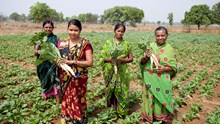
Cauliflower is one of the most widely consumed vegetables in India, valued for its adaptability and rich nutritional profile. In recent years, the focus on improving both yield and nutritional content has led to the development of innovative varieties. Among them, Pusa Beta Kesari 1, introduced by ICAR-IARI, New Delhi, represents a major breakthrough. This is India’s first indigenously developed biofortified cauliflower variety rich in beta-carotene, a precursor to vitamin A—vital for vision, immunity, and overall health.
Nutritional Innovation and Public Health Impact
Beta-carotene deficiency is a significant public health concern in India, especially in rural areas. Pusa Beta Kesari addresses this by offering a reliable dietary source of beta-carotene, thereby helping reduce dependence on supplements. The curds of this variety contain 8.0 to 10.0 ppm of beta-carotene (800–1000 µg/100g), making it a powerful tool in combating micronutrient malnutrition.
Unique Traits and Visual Appeal
What sets this variety apart is its orange-colored curds, a visual indicator of its enhanced nutritional value. This distinctive coloration not only signals higher beta-carotene content but also makes it more appealing in markets where differentiation and visual quality are key selling points. Its semi-self-blanching growth habit helps in naturally protecting the curds from sunlight, maintaining their quality and reducing manual labor typically required for blanching.
Agronomic Features and Yield Potential
Released and notified during 2015–16, Pusa Beta Kesari is tailored for the National Capital Region (NCR) of Delhi, where it thrives under September to January cultivation. Adapted to rainfed conditions, it’s an ideal option for resource-limited farmers seeking dependable returns. With an average marketable curd weight of 1.25 kg and yields ranging from 42 to 46 tonnes per hectare, it offers impressive productivity. Under optimal management, it can reach 2.37 t/ha average yield, enhancing farm profitability.
This pureline variety, developed through traditional breeding methods, ensures uniformity in field performance, making cultivation predictable and manageable. It performs best in well-drained loamy soils rich in organic matter and responds well to balanced nitrogen and potassium fertilization, which also helps retain its nutritional quality.
Market Potential and Farmer Advantages
As awareness of biofortified foods increases, Pusa Beta Kesari is gaining traction not just for its nutritional profile, but also for its economic viability. Its vibrant appearance and health benefits contribute to a growing demand among consumers, particularly in organic and specialty markets. For farmers, the high yield potential, reduced labor needs due to its self-blanching nature, and suitability to non-irrigated farming systems make it an attractive and sustainable option.
A Step Toward Sustainable Agriculture
Pusa Beta Kesari 1 is more than just a crop—it represents a strategic advancement in biofortification and sustainable agriculture. It serves the dual goals of improving public health and ensuring economic security for farmers. With supportive policies, greater awareness, and wider seed distribution, this variety could play a significant role in strengthening nutritional security in India.
By combining nutritional enhancement with agronomic robustness, Pusa Beta Kesari 1 stands as a model of how smart plant breeding can address real-world challenges, benefiting both producers and consumers alike.
















